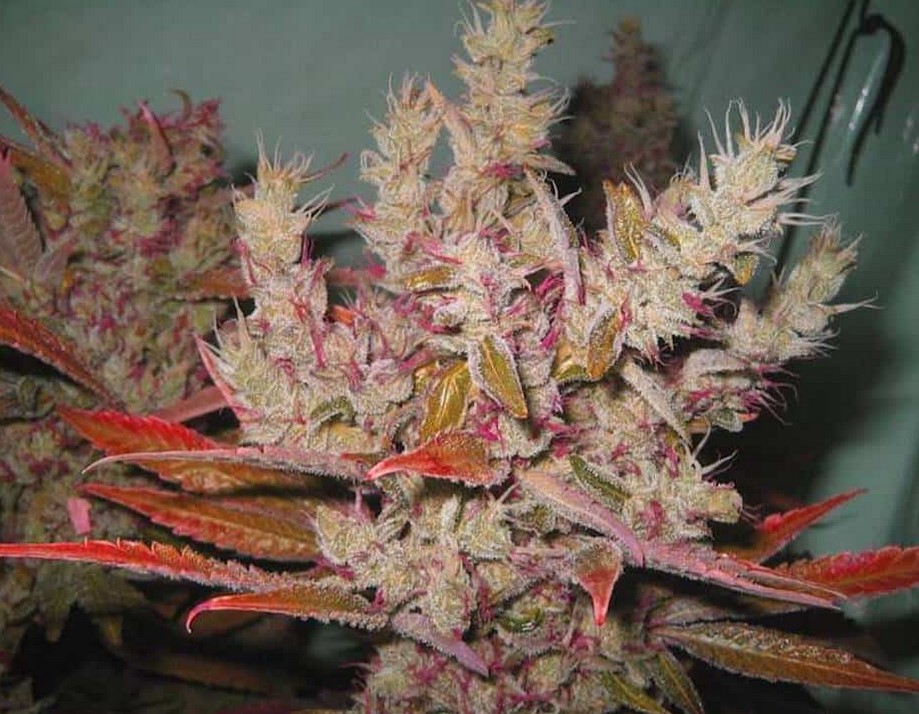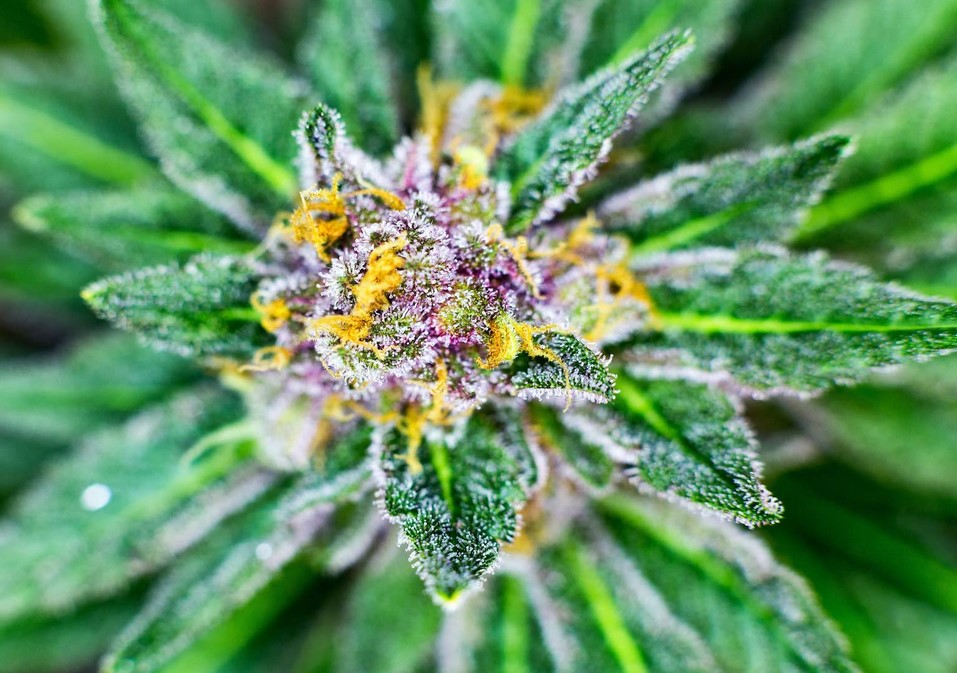Non classé
Colourful Weed: Bud Colors Guide
Customers made their decisions mostly based on smell and color long before cannabinoid testing began. After that, flavor and, of course, strength. There is nothing more attractive than a jar with brilliant buds today, with all the information we have accessible when purchasing marijuana.
Those pigments that give flowers and fruits their colors come from a class of molecules called anthocyanins. These are synthesized through the phenylpropanoid pathway and they show up in all higher plant tissues– think leaves, roots, stems, etc. They don’t have an odor usually, but can be slightly astringent. Their hue depends on their pH level and can be purple, red or blue.
Consider the leaves of a tree in the fall. They turn from green to red, orange, yellow, or gold as the temperature drops. Cannabis works in a similar way: when the green fades away, the colors appear.
The temperature is also important. Chlorophyll, which is essential for photosynthesis, slows down in cooler temperatures. For cannabis plants, this can cause certain colors to appear when the temperature drops and the light cycle becomes shorter, simulating a change in season.
Cannabis plants require a pH of 5.5 to 6.5; however, during blooming, you may lean one way or another to enhance or reduce specific anthocyanins to produce certain hues. Various cannabis strains also have various cannabinoid ratios, flavor profiles, and anthocyanins.
Anthocyanins are a type of natural pigment found in a wide range of plants, including blueberries. They can be found in plant leaves and flowers, as well as trichomes, the tiny hairs or outgrowths or appendages on plants. They may also attract pollinators like butterflies and bees while keeping pests at bay.

A common misconception is that strains with bold color are more potent. The truth is that color has nothing to do with potency.
In fact, buds that have been developed and harvested to the hilt might be so clogged with trichomes that they appear white. Terpenes and cannabinoids are packed in trichomes, which means these blooms can be quite powerful. White Rhino or White Widow are two strains that tend to get clogged with trichomes.
However, anthocyanins are known to be powerful antioxidants and are also thought to have pain-relieving, anti-inflammatory, and neuroprotective properties. While the presence of anthocyanins does not alter the amount of cannabinoids like THC present in a souche, it may provide an entourage effect on health due to their antioxidant and anti-inflammatory effects.
Other plants that are rich in these molecules include blackberries, blueberries, raspberries, goji berries, blood oranges, and cranberries. Cranberries especially are known for their powerful antioxidant properties, which are due to anthocyanins.
Not only does strong and vibrant color indicate that your cannabis is fresh, but it also packed with nutrients like carotenoids, anthocyanins, and flavonoids. But what role does actual color play? If you’re consuming your colorful bud orally in tinctures, oils, edibles, or capsules form, different shades can determine varied effects like taste and smell.
ROYGBIV – Taste the Rainbow
Red: Red hairs are more common, but red buds and leaves are not. Red cannabis is a genetically created plant that combines three types of cannabis: ruderalis, indica, and sativa. It’s a very unusual plant. The “Red” is best recognized for its hybrid effects, which provide both body and mental relief while also having an intoxicating scent.
Some other delightful pink shades are Predator Pink and Pink Kush, presenting actual pink and fuchsia hues. These particular strains are Indica-dominant hybrids, meaning they have stronger effects on the body like pain relief, insomnia prevention, and increased appetite.
Orange: Cannabis contains carotenoids, which give it the yellow, gold, and orange hues characteristic of citrus fruits. To create these colors, a higher alkalinity is required. If the plant displays these colors naturally as it nears its end in the blossoming stage,
Orange will mostly impact the hair and buds, including Agent Orange, Orange Crush, or Tangerine Dream. These strains are known for their fragrances of freshly cut citrus and are excellent mood boosters.
Yellow: Carotenoids produce the range of warm hues often found in nature, for example in carrots, squash, sweet potatoes, pumpkins, and tomatoes. There are over 750 different carotenoids that have been identified by scientists thus far – many of which can be converted into Vitamin A by the human body. In addition to carotenoids,. Many flavonoids are also yellow and can influence the colors of cannabis plants.”
The yellow strains of cannabis are characterized by their sweet and citrusy scents. These strains include Lemon Haze, Golden Lemon, and Strawberry Banana. They are said to produce psychoactive effects that sharpen creativity and sensory awareness.
Green: Because of the presence of chlorophyll, most flowering plants, including cannabis, are green. Plant tissues may have so much chlorophyll that the green color camouflages other colors.
Cannabis strains that retain green as the dominant bud color include Green Crack and Green Goblin. With a tangy, fruity flavor redolent of mango, Green Crack is a great daytime strain known to fight fatigue, stress and depression.
Blue: Cannabis flowers with shades of blue are high in anthocyanins and are by far some of the most beautiful. Likewise, fruits and vegetables high in anthocyanins include blueberries, açai, raspberries, blackberries, and purple cabbage. Blue-hued cannabis can be achieved by picking a blue strain of cannabis seeds and letting it grow outdoors, naturally occurring as the temperature drops.

Blue cannabis originally came from Dutch Passion’s Blueberry, created in Amsterdam back in the 1970s. If you’re looking for similar strains, try researching Blue Haze, Blue Mystic and Blue Cheese. These powerful Indica strains are commonly used by people seeking a way to relax or relieve muscle spasms, pain or stress.
Indigo: Some strains of black cannabis are so dark they look almost black. The Vietnamese landraces, like Vietnamese Black, are the original source of these genetics. All other strains derived from hybrids, such as Black Willy and Black Tuna, share both the signature ebony buds and leaves.
Besides boasting an intense visual appearance, black strains also offer smokers a psychedelic and cerebral high. If you want visuals, this lineage is for you. The inky appearance comes from an overabundance of all colors in the leaves.
Violet: Purple is without a doubt one of the most common hues in cannabis. This may be due to granddaddy purples, purple hazy strains, and purple urkles, which are all examples of marijuana plants that ARE green but appear blue or purple due to the presence of a large amount of anthocyanins.
The Purple Orangutan Gorilla has some of the strongest purple hues in the world. This mostly indica hybrid produces lush, chunky buds covered in trichomes and purple shades. The flowers smell of fresh earth and an array of berries, with a taste reminiscent of grapes picked right from the vine.
How Does Weed Get Its Color?
We’re about to get a little science-y on you but we promise it’s fun — this is herbe science after all. So how does weed get its color? Well, it depends on what colors you’re talking about.
For our favorite green nugs, chlorophyll is the culprit, which you may remember from science class back in the day. This chemical compound that is found in nearly every plant is responsible for turning sunlight into energy for the plant. In other words, the same thing that makes your lawn green is the same thing that gives weed its traditional grassy hue.
When it comes to the more uncommon colors like red, purple, orange, and even black buds, the answer is a little more complex. Based on genetics and environmental factors like temperature and nutrition, the cannabis plant starts to produce pigments known as anthocyanins. While this word may sound like a bunch of gibberish, you’ve already seen these guys at work in fruits and vegetables like raspberries, cabbage, and eggplants — just like cannabis, anthocyanins give them their rich color too.
Smoke The Rainbow
Now that we have science out of the way, it’s time for the fun part: which buds are going to dazzle your smoking buddies with their colorful display. While each strain of cannabis is different, there are generally a number of strains you can count on for a colorful smoking experience.
Grandaddy Purp
Grandaddy Purple — otherwise known as GDP for short — has been a staple in California’s indica-heavy scene since the start of the early 2000s. Born from a cross between Purple Urkle and Big Bud, GDP is one of the weed world’s most notorious purple varieties, with a delicious dash of berry flavor to match its good-enough-to-eat purple coloring.
First introduced into the market by famous cultivator Ken Estes in the San Francisco Bay Area, Grandaddy Purple has set the bar for purple strains around the globe, with name drops by the likes of every hip-hop artist from Lil Wayne to G-Eazy. Needless to say, this purple bud is a fan favorite.
Forbidden Fruit
A blend of Cherry Pie and Tangie, Forbidden Fruit is a colorful strain that usually leaves people feeling relaxed yet euphoric and light. It gets its name from its drool-worthy tropical taste, with notes of mango and passionfruit, but long before you even discover the flavor, you’ll be enamored by its unforgettable appearance.
Color-wise, this near-perfect strain stands out from the pack with light green leaves that are layered on top of dark green leaves, all completely wrapped in a layer of fuzzy orange hair. Go one step further by breaking apart the nugs and you’ll be delighted with a display of pink undertones. All in all, one look at these buds and you’ll want to take a bite out of this Forbidden Fruit too.
The Black
A pure purple strain that can be traced back to both Canada and California in the wild wild west of pre-legalization times, The Black gets its heavy metal-inspired name from its dark coloring, with buds so richly purple that they’re often mistaken for black.
In addition to the Black’s dark and frosty appearance, its indica-dominant attributes will have you melting into your couch with a smile on your face. While it is a difficult strain to find, its reputation is unmatched in both color and effects.
Rose Kush
Rarely making an appearance as the main color, pink will often make show up on the little hairs found on nugs called stigma. While their color is subtle, it does make a big impact on certain strains like Pink Kush.
Sometimes called Pink OG, Pink Kush comes from the OG Kush lineage. In addition to its signature blush tone, it can also come in green or a mix of purple and green, with a slight pink shine tucked away inside the buds like a special surprise. Although these buds may sometimes appear to have very little actual pink on them, the full plant will grow with a stunning amount of beautiful pink stigma right before the buds are harvested.
Aurores boréales
Resulting from a combination of Afghani and Thai strains, this cultivar is known for crystal-covered leaves that seem to twinkle like the night sky. The nugs are dusted with sparkly residue that makes this anxiety-reducing indica look like the cosmos — and may take your mind there too. It is known to send those enjoying it off into space and ready for a night of restful, pain-free sleep.
It also offers a spicy yet sweet flavor that makes it great for both at-home edibles and bong rips. While it may not be the brightest or the boldest on this list, its unique starry effect makes it sparkle just a bit brighter than the competition.
Final Words
While these are some of the most infamous colorful cannabis strains in the game, new strains continue to fight it out for the top spot every day. As we continue to dive deeper into the science of weed, we discover new ways to bring the plant’s color to life and onto our dispensary shelves. Pull up to Uberweed today and find what colorful buds we have for your smoking pleasure — we’re kinda like the pot of gold at the end of a weed rainbow.


